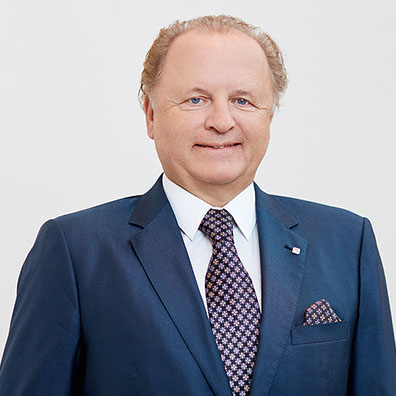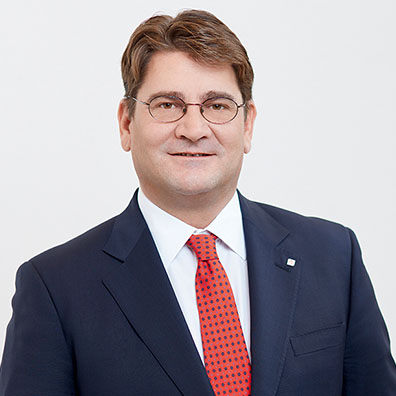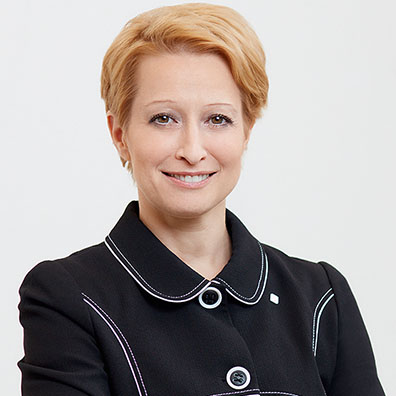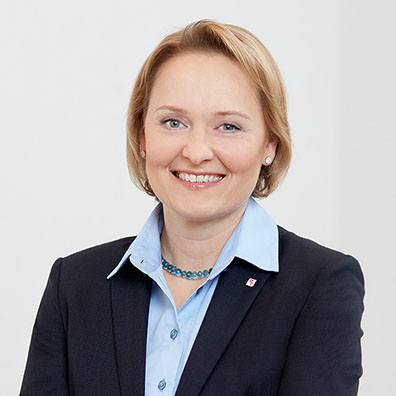“The focus is on sustainable growth”
VIG has another year of success and hard work behind it. In 2017, the Group made further significant steps towards setting the course for the future. An interview with the Managing Board on the benefits of diversity, opportunities in the CEE region and first progress made through the Agenda 2020.

The VIG Managing Board: Judit Havasi, Franz Fuchs, CEO Elisabeth Stadler, Peter Höfinger, Martin Simhandl and Liane Hirner (from l. to r.)
Ms Stadler, how satisfied are you with the 2017 reporting year?
Elisabeth Stadler: Premium and profit growth are the encouraging results we achieved through systematically following our business strategy. They prove once again that we are a stable, reliable partner. We took many steps in the year behind us to ensure that we are well-equipped for future challenges. We are promoting the digital transformation of the entire Group, working to expand the bank insurance business and dedicating ourselves with great energy and enthusiasm to other initiatives in our strategic work programme Agenda 2020.
“Premium and profit growth are the encouraging results we achieved through systematically following our business strategy. They prove once again that we are a stable, reliable partner.”
Elisabeth Stadler

Mr Simhandl, as the CFO how do you assess VIG’s performance?
Martin Simhandl: We continued the upward trend that had started in the previous year and further improved our result compared to 2016. Group premiums written rose 3.7% to EUR 9.4 billion. After adjusting for the single premium life business, where we intentionally continue to follow a cautious underwriting policy, this rose by 6.2% even. Our result before taxes significantly rose by 8.8%. This was due to the full consolidation of the non-profit societies over the entire year and good development in the insurance business.

“We continued the upward trend that began in the previous year and further improved our result.”
Martin Simhandl
What do you think of the opportunities and risks in Central and Eastern Europe?
Franz Fuchs: We can sense the economic upswing that began in 2017. People are more confident about the future again. They benefit from economic growth which implied higher consumer spending in 2017. This confirms our belief that the CEE region offers great potential and we are perfectly positioned to take advantage of these opportunities. Of course, problems can arise in individual markets from time to time, due to regulatory changes for example. But being able to rely on local management allows us to easily handle challenges like these. And regional diversity, product diversity as well as distribution channels within the Group reduces our overall risk exposure.
“The CEE region offers great potential, and we are perfectly positioned to take advantage of these opportunities.”
Franz Fuchs

How do you expect business to develop in CEE in the future?
Stadler: We still see great potential for future growth of the insurance business in CEE. We want our business to grow continuously, both organically and through acquisitions – with a focus on sustainable growth. A business is sustainable only if it is profitable. In other words: we do not aim for growth for the sake of growth. We prefer targeted growth in selected business areas. In life insurance, we are focusing more on covering biometric risks and unit-linked products. In property and casualty insurance, we are promoting the non-motor business. We see particular potential in expanding health insurance, and are also setting very specific priorities in some markets.
Peter Höfinger: The same applies to acquisitions. We are always looking for good opportunities in the market. Not everything we see meets our requirements. We initiated acquisitions in the Baltic states and Bosnia-Herzegovina in 2017. The acquisition in the Baltic states is aimed to strengthen our leading position and to intentionally expand the non-life business in Estonia. As a result of the acquisition in Bosnia-Herzegovina, we are now represented in all parts of the country. Morover we strengthened the life insurance business and almost doubled our market share.
You introduced Agenda 2020 as a strategic work programme. How is implementation moving forward?
Stadler: Our goal with Agenda 2020 was to optimise our business model and take advantage of new business opportunities. Neither of these can be accomplished overnight. We are therefore very pleased to see the first progress after such a short period of time. In 2017, we decided to merge our local composite insurers with our life insurance companies that specialise in bank distribution in Austria, the Czech Republic, Slovakia, Hungary and Croatia. This allows us to combine resources and expertise to better assist our bank insurance partner Erste Group in providing customer advice and selling insurance products. This is of particular benefit to our customers. We want to take full advantage of the growth potential offered by bank distribution, especially for health and property and casualty insurance. We also want to simplify our products, make them more easily understandable and further integrate them into bank online sales.
What progress has been achieved with the other Agenda 2020 projects?
Fuchs: The measures for claims management are in the initial implementation or early roll-out phases. The pilot project in Poland even exceeded our expectations in terms of potential savings that could be achieved with the closed file review by using VIG’s specific method. The next step will be to add each country and line of business one after the other. These measures will help us further reduce our combined ratio towards 95%. The savings expected from the initiatives will also help achieve this goal. This applies, for example, to the synergy effects achieved by the mergers that Elisabeth Stadler previously mentioned, and the profit-optimising measures for motor insurance where we are initially focusing on optimising foreign claims. We managed to reduce the Group-wide combined ratio to 96.7% in the year just ended. And this was in spite of natural events like storm Herwart at the end of October, which created net Group-wide losses of around EUR 28 million until yearend.
The 2017 Group Annual Report is based on the motto “We embrace diversity”. Why is this message so important?
Stadler: Everyone is talking about diversity. But while the others are just talking, we have always lived by this principle. Dealing openly with diversity is an important success factor for VIG. The way we approach customers differs from country to country. We therefore intentionally rely on regionally established brands and the expertise of local management. Our presence in many different markets with various brands and distribution channels also allows us to remain successful, even in challenging times.
Höfinger: We are a company that respects local cultures and does not try to standardise everything. We are proud of that. Above all, we are also convinced that this approach makes us more successful.

“We are a company that respects local cultures and does not try to standardise everything. We are proud of that.”
Peter Höfinger
How does the idea of diversity fit with digitalisation?
Stadler: We give our Group companies the freedom and independence to start with digitalisation projects and turn their ideas into reality. We developed a digital vision for our campaign in 2017 that is aimed at helping each insurance company with the transformation process from their own specific starting point. Speed, priorities and measures can differ from company to company. VIG Holding plays a supporting role for the Group companies in this regard.
How is VIG’s IT landscape changing, in particular with respect to digitalisation?
Judit Havasi: Although our IT landscape is generally decentralised, we make sure that proper interfaces exist. This also creates a foundation for intelligent use of data, as defined in our digital vision. Austria provides an example that illustrates current developments: Our Group companies Wiener Städtische and Donau Versicherung established two programmes that go hand-in-hand. The organisational programme is aimed at reducing the structural complexity of products and harmonising processes and rules. The second programme focuses on modernising IT solutions for insurance policy management. What I want to illustrate with this example is that just modernising the IT landscape is not enough to move digital transformation forward. We also want to examine our processes and give priority to simple, clear solutions.
What about VIG’s capital position, particularly with respect to Solvency II?
Havasi: VIG has a solvency ratio of 220% calculated at the level of the listed Group, and 389% for VIG Holding as an individual company. Our solvency ratio therefore puts us in a good position for the future.
“Our solvency ratio puts us in a good position for the future.“
Judit Havasi

Simhandl: The 2017 bond issues by VIG and Wiener Städtische also illustrate our long-term planning. We took advantage of the favourable interest rate environment to further improve our cost of capital structure.
How does VIG deal with the upcoming regulatory changes?
Stadler: There will always be new regulatory challenges. Among others, we had to deal with the General Data Protection Regulation (GDPR), Insurance Distribution Directive (IDD) and PRIIPs Regulation on key information documents for insurance-based investment products during the last financial year. The insurance industry is already heavily regulated and is continuously challenged by ever-stricter rules. This presents a major challenge for the entire industry. But VIG is well-prepared. VIG Holding offers Group companies help in implementing regulatory requirements in the form of workshops and individual advice.
Ms Hirner, you joined the Managing Board in February 2018. IFRS 17 is certain to be one of the first major challenges in your new position.
Liane Hirner: Yes, that is true. I am looking forward to it, and the other challenges I will meet as a Member of the VIG Managing Board. IFRS 17 will bring a new era of accounting to VIG and the entire insurance industry starting in 2021. New accounting principles will be used for insurance policies. The underwriting liabilities in the balance sheet will be remeasured, and their presentation in the income statement will be fundamentally changed. In the future, new KPIs will be used to compare insurance groups, or previously used KPIs will be drawn upon a new meaning. VIG started a Group-wide project in 2017 that is centrally managed from Vienna to ensure that sound preparations are made for IFRS 17 within the entire Group.

“IFRS 17 will bring a new era of accounting to VIG and the entire insurance industry starting in 2021.”
Liane Hirner
What goals has VIG set for the future?
Stadler: Dealing with the effects of the low interest rate environment continues to be a major challenge. Our response is that we will further improve profitability and push forward with strategic measures in Agenda 2020. The results have been excellent so far. We now expect that the targets we initially announced for 2019 will be achieved a year earlier. We have therefore adjusted our targets for 2020, and are now aiming for a result before taxes of between EUR 500 and 520 million, a premium volume in excess of EUR 10 billion and a combined ratio of around 95%. These are ambitious targets, but realistic nevertheless. As a result of our activities under Agenda 2020, we have succeeded in strengthening the open exchange of information and collaboration within the Group. We aim to continue using this positive climate. Only those who show willingness to change can be successful, reliable partners in the long term.